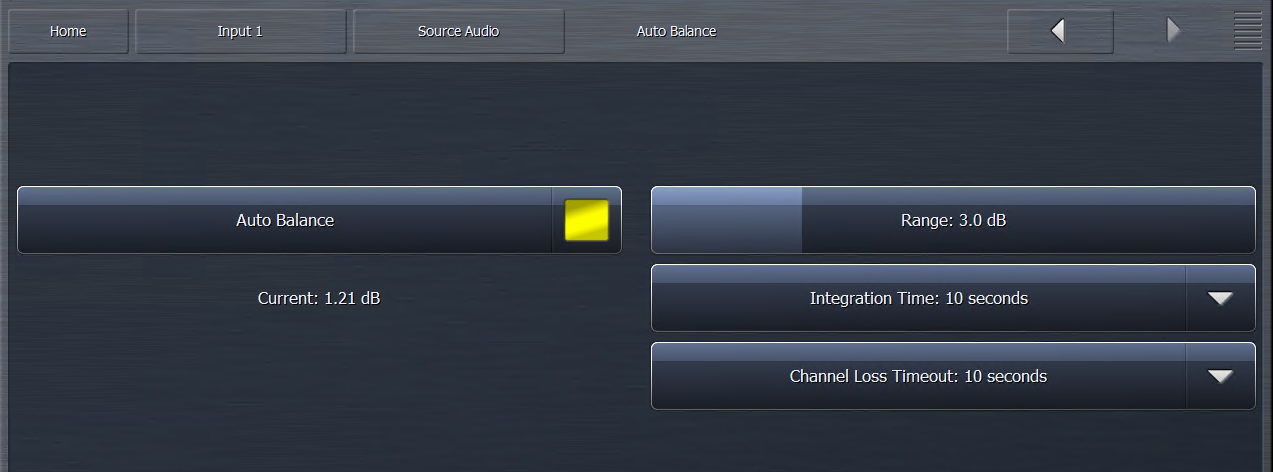Using the Omnia.9 Auto Balance Feature
Scope
This article explains how to use the Omnia.9's Auto Balance feature.
Setup
The Auto Balance feature does two distinctly different things.
Automatic Balance Control
First is literally “Automatic Balance Control”. There are two controls for this -- "Range" and "Integration Time":

It automatically adjusts Left / Right balance, so that they measure the same R128 loudness. The 3/10/30/60 second integration time actually refers to the standard time constants of the R128 algorithm used to drive the balance control!
When first developing this, Leif was not sure whether this would be a good idea if you played an old Beatles track with hard-panned instruments in headphones, so he simply tried it -- and greatly preferred the effect! It sounded better in headphones to equalize the loudness of hard-panned tracks, which have traditionally been very unpleasant to listen to in headphones, without needing to actually blend the channels together.
This also helps minimize L-R without really changing anything about the audio, other than.. automatically adjusting the balance control.
It also band-aids the problem of an analog XLR connection where the Hot or Cold comes loose on one channel, causing a -6dB level drop. Auto Balance compensates for this automatically.
Channel Loss
The second part of Auto Balance is the “Channel Loss Timeout” feature.
When not set to "Off", this checks whether a channel is completely missing and if so, duplicates the remaining channel into the empty channel so that the broadcast will be in mono, rather than all hard-panned to one side.
The available timeout settings before it will act are 3, 10, 30 or 60 seconds.
This is of course not to be used as an automatic fix of bad programming elements! If there are regular programming elements that are all-left or all-right, those should be fixed and not rely on the audio processor to do it. There will be at least a few seconds of one-legged audio before it blends over, and if the time constant is too short, certain songs that have hard-panned intros would be blended to mono when they shouldn’t be.
Here are three songs to be careful with:
- Norwegian Wood (Beatles) - Audio only in the right channel for the first five seconds
- Year of the Cat (Al Stewart) - Audio in the left channel only for 34 seconds (album version) or 22 seconds (single version/radio edit)
- Wish You Were Here (Pink Floyd) - Audio in the right channel only for the 60 seconds (album version) or 45 seconds (radio edit)
It may be best to set it to 60 seconds as there likely isn't a track that goes longer than that with only a single channel. The “risk” in using it is the same potential pitfall of using the audio source failover feature: It can mask a fault that needs to be addressed. When talent routinely listened off-air in the studio, loss of audio - either in one channel or the other, or at the source - was detected almost immediately. Now it can be minutes, hours, or days depending on who’s paying attention. This is where SNMP comes in handy.
Conclusion
Auto Balance can be handy for helping with dodgy analog L/R inputs. AES and AOIP systems have largely eliminated this issue, but in an analog plant, it was not at all uncommon for something in the signal path - a console channel, a distribution amplifier, a patch panel, a punch block, an XLR connector, an unbalanced-to-balanced “matchbox” - to introduce different left and right input levels.
It’s not supposed to be a band-aid for bad engineering practices or faulty wiring.
Another use for Auto Balance is more consistent channel-to-channel loudness. This disregards the artistic intent of material that was intentionally recorded with some L/R differences, but in noisier environments like a car, it can be beneficial. Using it in this way is not unlike running the old Texar Audio Prisms unstrapped (L/R independent) which was the most common way to set them up.
Let us know how we can help
If you have further questions on this topic or have ideas about improving this document, please contact us.
